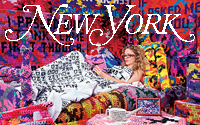
March 5, 2007
Highraff, Street Artist
 Street artist Highraff recently came to the United States for the first time to raise awareness about the culture of his hometown São Paulo, Brazil, where he’s been painting in the streets since 1997. The twenty-nine-year-old artist, whose given name is Rafael Calazans Pierri, currently has work on display here in New York as part of Ruas de São Paulo: A Survey of Brazilian Street Art at the Jonathan LeVine Gallery. If you think his psychedelic murals are coming off the walls, it’s because he uses MDF material to turn colorful scenes into three-dimensional sculptures. Gothamist caught up with Highraff and asked him what he thinks about the New York graffiti scene.
Street artist Highraff recently came to the United States for the first time to raise awareness about the culture of his hometown São Paulo, Brazil, where he’s been painting in the streets since 1997. The twenty-nine-year-old artist, whose given name is Rafael Calazans Pierri, currently has work on display here in New York as part of Ruas de São Paulo: A Survey of Brazilian Street Art at the Jonathan LeVine Gallery. If you think his psychedelic murals are coming off the walls, it’s because he uses MDF material to turn colorful scenes into three-dimensional sculptures. Gothamist caught up with Highraff and asked him what he thinks about the New York graffiti scene.
What do you think of New York so far?
New York is a big city, like São Paulo, but with the difference of [New York] being a big city in the First World, we see less misery but more unconsciousness, people living in a system of consumerism and manipulation, people without freedom [because of] the system watching each step and telling [people] what to do. On the other hand, this system works better than the Third World’s: the government helps people with health care and education. The worst is the FEAR and GUILT that people feel in the air, fear of terrorism, xenophobia, guilt for polluting and making war all over the world. The best in New York is the worldwide culture, art, music, cinema, and food.
Tell us about your experience painting the mural at the school in the Bronx. What were people’s reactions?
It was really cold that day, difficult to paint, hold the can, and control the paint against the wind. But it was a really nice experience! The school’s walls are great surfaces and the neighborhood was popular and residential so the art will reach the people that deserve it. The kids were very enthusiastic with the permission to paint, an unusual thing for them. And our paintings have such a different style from NY’s graffiti. They asked a lot of questions like why we paint that way? Why there [are no] letters in the piece? And, what is that? Abstract graffiti was something that they really didn’t know before and it made them think and question it.
How does it feel to make a permanent mark on New York?
New York has a big importance for being the cradle of graffiti culture that represents a movement of youth resistance against control. We had a lot of fun painting in the place that graffiti was born and showing feedback of our influence from there. I feel good about it, and I want to come back and paint more in other neighborhoods like Brooklyn, Harlem, Queens, etc.
If you could make your street art any place in New York City, where would you pick?
Places where poor people live and pass going to work, and places that can give me good surfaces and good backgrounds for pictures.
Have you seen a lot of graffiti here in New York? What do you think of it? How does it compare to graffiti in Sao Paulo?
Graffiti in New York is traditional. [There’s a lot of] hip-hop style, letters, wild styles and some characters, a lot of quick bombing, bubble trow-ups, and a lot, really a lot of tagging. I like to see it but I don’t like making the same styles. Here it is harder to paint than São Paulo. Your laws against graffiti are strong and people are influenced to call the police if they see something. So New York writers make a lot of tagging and bombing that is less dangerous because it is quicker. In São Paulo we have the possibility to stay longer at a wall and work more on the pieces. We have the influence of different things like other forms of art and Brazilian culture and so we have a bigger diversity of styles in the streets.
Recently, someone known as "The Splasher" has been splashing paint over other people’s street art here in New York. What do you think about that?
I don’t support that kind of attitude but it happens, It’s part of the graffiti game.
Who are your favorite artists? Who and what inspires your art?
From the old masters I like Klimt, Alfons Mucha, and Mc Escher. From São Paulo street art I have big respect for Os Gemeos, Vitche, and Herbert Baglione. I’m inspired by tribal, Indian, modern and contemporary art to graffiti, architecture, design, cartoon, psychedelic art and music…. But Nature is my bigger influence. The art from the Great Spirit.
What do you do when you’re not painting?
I stay with my wife and my puppy, family, and friends. I draw, listen to music, network on the Internet, and travel to seek inspiration in the natural higher levels.
If you weren’t an artist, what career path would you choose?
I’d choose to be an eagle, a cougar, or a dolphin.…
Photo Credit: Ignacio Aronovich & Louise Chin / LOST ART
Posted by Stephanie Nikolopoulos in Interview






